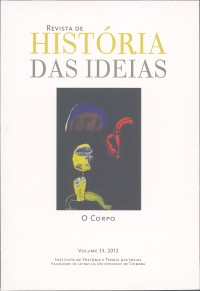Please use this identifier to cite or link to this item:
https://hdl.handle.net/10316.2/41371| Title: | Quando a gordura começou a deixar de ser formosura...: os caminhos de um novo paradigma estético nos finais do século XIX - inícios do século XX | Other Titles: | When plumpness stopped being fairness...: the construction of a new aesthetical body ideal at the end of the 19th century - beginning of the 20th century | Authors: | Vaquinhas, Irene | Issue Date: | 2012 | Publisher: | Imprensa da Universidade de Coimbra | Abstract: | Neste trabalho sobre a evolução histórica dos cânones estéticos da beleza
feminina em Portugal, incide-se na passagem do modelo de "gordura-formosura"
para o de "beleza-magreza", o que ocorre num momento particular da história
do país: a transição da Monarquia para a República, no final do século XIX, início
do século XX. É feita a fundamentação ideológica dos discursos subjacentes
a esses modelos (tanto da parte da religião como da política e, sobretudo, da
medicina), bem como a caracterização social do seu público-alvo, concluindo-se
que a noção de "esbelteza" se dirige prioritariamente às mulheres dos estratos
sociais elevados, reservando-se o modelo estético assente nas formas corporais
"robustas e arredondadas" para os estratos sociais inferiores, sobretudo urbanos,
procurando-se assim controlar o que então se designava pela "decadência
fisiológica da raça portuguesa". The central topic of this paper is the historical evolution of the aesthetic canons of female beauty in Portugal. The author focuses on the shift from the model of the "plump beauty" to that of the "slim beauty", which took place at a particular moment in the country's history: the transition from the Monarchy to the Republic in the late 19th and early 20th century. She discusses the ideological grounding of the discourses of religion, politics and especially medicine regarding these models, and characterizes their target audience in social terms. Her findings show that the notion of "slimness" was primarily directed towards upper class women, whereas the aesthetic model of "robust and plump" bodily forms was reserved for women of the lower, especially urban, social ranks, thus seeking to control what was then called the "physiological decay of the Portuguese race". |
URI: | https://hdl.handle.net/10316.2/41371 | ISSN: | 0870-0958 2183-8925 (digital) |
DOI: | 10.14195/2183-8925_33_11 | Rights: | open access |
| Appears in Collections: | Revista de História das Ideias |
Files in This Item:
| File | Description | Size | Format | |
|---|---|---|---|---|
| quando_a_gordura_comecou_a_deixar_de_ser_formosura.pdf | 620.19 kB | Adobe PDF |  |
Items in DSpace are protected by copyright, with all rights reserved, unless otherwise indicated.
